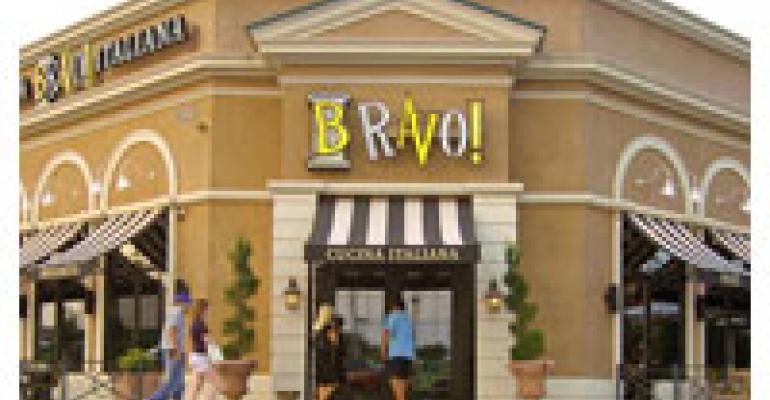
We can’t tell you if you should invest in the Bravo Brio Restaurant Group’s initial public offering when it comes out. But it’s worth a closer look at the company’s IPO filing with the Securities and Exchange Commission to see an out-of-the-ordinary full-service restaurant business model that seems to really work.
You’re on your own when it comes to sorting through the many financial facts contained in Bravo Brio’s IPO (see it at www.sec.gov/Archives/edgar/data/1495479/000095012310063303/l40038sv1.htm). But we can all appreciate how this Columbus, OH-based company has been able to grow its portfolio of Italian restaurants from 49 units in 2005 to 83 today, a historically lousy period in which to open big new restaurants. Clearly, Bravo Brio is doing something right.
It’s succeeded by using two concepts that, to an outsider, seem unusually close in almost every aspect of their operation.
The company has 46 Bravo! Cucina Italiana restaurants in 19 states. Bravo, the IPO document tells us, “is a full-service, upscale affordable Italian restaurant offering a broad menu of freshly-prepared classic Italian food served in a lively, high-energy environment with attentive service.”
The Brio Tuscan Grill side of the business includes 37 restaurants in 17 states. Brio “is an upscale affordable Italian chophouse restaurant serving freshly-prepared, authentic northern Italian food in a Tuscan Villa atmosphere.”
The Bravo check average is $19.37 and average unit volumes are $3.5 million. Brio runs a $25.12 check and average unit volumes are $4.8 million. Menus and décor schemes differ a bit between the two, but both Brio and Bravo deliver a level of food and sense of event that makes their final tabs seem reasonable.

Were you to go to a Bravo one night and a Brio the next, you’d likely conclude these two concepts, while not identical, aren’t all that different. You’d think they’d cannibalize each other’s business in markets where units of each are located close together. In practice, significant synergies result instead.
The IPO filing spells out the strategy behind this setup.
“We have developed two premier upscale affordable Italian restaurant brands that are highly complementary and can be located in common markets. Both Bravo! and Brio have their own corporate executive chef who develops recipes and menu items with differentiated flavor profiles and price points. Each brand features unique design elements and atmospheres that attract a diverse guest base as well as common guests who visit both Bravo! and Brio for different dining experiences. The differentiated qualities of our brands allow us to operate in significantly more locations than would be possible with one brand, including high-density residential areas, shopping malls, lifestyle centers and other high-traffic locations.
“Based on demographics, co-tenants and net investment requirements, we can choose between our two brands to determine which is optimal for a location and thereby generate highly attractive returns on our investment.
“Our brands are designed to have broad guest appeal at two different price points. We focus on choosing the right brand for a specific site based on population density and demographics. Management targets markets with $65,000 minimum annual household income and a population density of 125,000 residents within a particular trade area for Bravo! and $70,000 minimum annual household income and a population density of 150,000 residents within a particular trade area for Bio.”
We also learn from the SEC filing that 62 percent of Bravo! Guests are women, as are 65 percent of Brio customers. A majority of customers dine at one of the two concepts at least once a month. No wonder Bravo and Brio are so attractive to developers and landlords.
“Our differentiated brands, the attractive demographics of our guests and the high number of weekly guest visits to our restaurants have positioned us as a preferred tenant and the multi-location Italian restaurant company of choice for national and regional real estate developers. Landlords and developers seek out our concepts to be restaurant anchors for their developments as they are highly complementary to national retailers such as Apple, Williams Sonoma and J. Crew, having attracted on average between 3,000-5,000 guests per restaurant each week in 2009. As a result of the importance of our brands to the retail centers in which we are located, we are often able to negotiate the prime location within a center and favorable real estate terms, which helps to drive strong returns on capital for our shareholders.”
In all, the SEC filing makes a strong case for building a restaurant company using differentiated yet complementary brands. No date has been set yet for the IPO, which hopes to raise $172 million to fund future growth. But if the numbers look good to you, you may wish to invest when it does…or start your own restaurant business with two so closely related brands.





